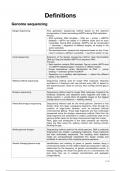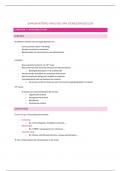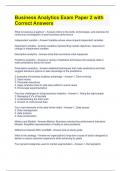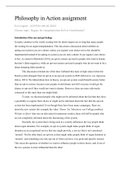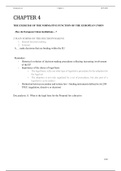Lecture 1: Introduction to Sustainable Innovation
Key points (of course):
Organizing for sustainable innovation implies a shift away from a reactive approach to a
proactive approach
● Sustainability is not a means to be compliant/greenwashing but being a leader as a
company
Guiding questions:
● How can companies take advantage of business opportunities by focusing on
sustainability?
● How can companies systematically design their processes and interactions with
stakeholders to develop innovative products, services that have sustainability at their
core?
● How can companies have an innovative advantage to their competitors by focusing on
sustainability in the beginning?
Business Sustainability
Why is business sustainability important?
We live in a world shaped by business:
● Access to goods to fulfill our needs
● Negative impacts on employees
● Tackling grand challenges reveals the impossibility of carrying on business as usual
● Economy depends on a healthy society and intact environment
Sustainable development: development meets the needs of the present, but has a future
development aspect which preserves Earth’s life-support system and welfare of current and
future generations
Planetary boundaries
● We may be reaching a tipping point
● We don’t know when or if we are reaching a tipping point
● In which aspects are we reaching a tipping point?
● How many chemicals can we have in an environment before we reach a tipping point?
● How much can we lose/global warming can we have before we reach a tipping point?
● What can businesses do to have an impact on these factors?
Sustainability is not corporate social responsibility (Bansal/DesJardins)
● There is a willingness to do something on behalf of the company, but it isn’t sustainable
because an issue is still happening (it's not being solved)
1
,Main differences between sustainability and CSR
Differences Sustainability CSR
Time scales Long-term thinking More immediate thinking
Focus and scope Tied to the profitability of Focus is on ethics, morality
(paradigms) business, where we want to go and norms
when implementing innovation
to reach sustainability targets
Validation and External certification through Internal impact measures
motivation focus on growth opportunities and enhancing a business
aligned with larger system that reputation (e.g., philanthropy
an organization is embedded or community volunteering)
in
How do we consider time as an important feature of sustainability? Move from Profit-Planet
tradeoffs towards time
● Example. Nike Fly knit leads to less material used and less material wasted
○ Use a single thread instead of cutting materials
○ Innovation stimulating efficiencies
But what about the temporal aspect? What if this technology leads to sale of more shoes,
which enter the waste stream that weren’t recycled?
● Need to consider that long term effects could be worse as opposed to better
● Toward intertemporal tradeoffs: Organizations tend to prioritize short-term thinking over
long term
Threats of short-termism
● Bias for immediate gratification
● Reinforced by urgency and uncertainty
● Focus on operations, neglect strategic investments
● Can lead to suboptimal outcomes
● Highly volatile outcomes, further increasing risk-taking
● Vicious circle
Example: Unilever switched its equity sharing to half yearly instead of quarterly. This initially
made shareholders angry and led to an initial loss in shares, but over time increased it (paid
back)
● Example of what happens when a company switches to long-term thinking
Investors and sustainability
Investors care more about “sustainability” (long term investments)
● More investors are thinking that sustainability is good for performance
● Three reasons why sustainability is important for performance:
○ Potential for long term value creation
○ Improved revenue potential
2
, ○ Offers better operational efficiency
● But companies still struggle
○ 90% actually agree that sustainability is important
○ 60% say they have a sustainable strategy
○ And only 25% have a positive business case for sustainability (so organizations
aren’t doing it yet)
○ There’s a difference between sectors:
■ Example: Media companies often place sustainability strategies low on
their agenda
● May be because there aren’t any laws in place pushing those
industries to be more sustainable, as compared to chemical
companies which require having safer legislations in place
Sustainability as a driver of innovation
Compliance as an opportunity
● New US emission standards will add high costs to vehicles but within 3 years will pay it
back
● Chrysler-Fiat CEO Sergio Marchionne: “It will be a huge boost for the industry. It’s like
walking into a toy store, and you can use any toy off the shelf to get you there.”
Manufacturers can reduce the fuel consumption and CO2 emissions of essentially every
vehicle by over 45 percent with these low-cost, incremental technologies.
In the making EU regulations on plastics
● Single use plastic directive: banned single use plastic on July 3rd
● Wants to negotiate a regulation that bans intentionally used microplastics (used in e.g.
cosmetics, paint, fertilizer, football pitches)
● The negotiation process is cost-benefit talks, but many organizations fear losing their
competitive advantage
● Tradeoffs between product qualities and what we need to do (what the right thing to do
is) appear
3
, In search of right capabilities
● Capability
○ Formally: Collection of routines, together with inputs, allow a firm to consistently
produce a set of actions towards an outcome (Winter, 2003).
○ Hargadon (2015): Elements (practices, tools, people) of an organization that
supports each other to accomplish an activity as a skill (relatively better than
others).
● Stable times vs. turbulent times
○ Dynamic capabilities: ‘meta-capabilities’ for change – sensing, seizing,
transforming
○ Best practices alone do not suffice – firms also need to have specific capabilities
to succeed in sustainable innovation
○ Identification of capabilities are a key
Lessons learned
• Idea is just the beginning
o What is really needed are the right capabilities to bring innovation to market
• Where you want to go determines what you need to go there
o Challenges are common (to some extent)
• There is a set of common capabilities in the pursuit of sustainable innovations
o We will go through them each week
4
Key points (of course):
Organizing for sustainable innovation implies a shift away from a reactive approach to a
proactive approach
● Sustainability is not a means to be compliant/greenwashing but being a leader as a
company
Guiding questions:
● How can companies take advantage of business opportunities by focusing on
sustainability?
● How can companies systematically design their processes and interactions with
stakeholders to develop innovative products, services that have sustainability at their
core?
● How can companies have an innovative advantage to their competitors by focusing on
sustainability in the beginning?
Business Sustainability
Why is business sustainability important?
We live in a world shaped by business:
● Access to goods to fulfill our needs
● Negative impacts on employees
● Tackling grand challenges reveals the impossibility of carrying on business as usual
● Economy depends on a healthy society and intact environment
Sustainable development: development meets the needs of the present, but has a future
development aspect which preserves Earth’s life-support system and welfare of current and
future generations
Planetary boundaries
● We may be reaching a tipping point
● We don’t know when or if we are reaching a tipping point
● In which aspects are we reaching a tipping point?
● How many chemicals can we have in an environment before we reach a tipping point?
● How much can we lose/global warming can we have before we reach a tipping point?
● What can businesses do to have an impact on these factors?
Sustainability is not corporate social responsibility (Bansal/DesJardins)
● There is a willingness to do something on behalf of the company, but it isn’t sustainable
because an issue is still happening (it's not being solved)
1
,Main differences between sustainability and CSR
Differences Sustainability CSR
Time scales Long-term thinking More immediate thinking
Focus and scope Tied to the profitability of Focus is on ethics, morality
(paradigms) business, where we want to go and norms
when implementing innovation
to reach sustainability targets
Validation and External certification through Internal impact measures
motivation focus on growth opportunities and enhancing a business
aligned with larger system that reputation (e.g., philanthropy
an organization is embedded or community volunteering)
in
How do we consider time as an important feature of sustainability? Move from Profit-Planet
tradeoffs towards time
● Example. Nike Fly knit leads to less material used and less material wasted
○ Use a single thread instead of cutting materials
○ Innovation stimulating efficiencies
But what about the temporal aspect? What if this technology leads to sale of more shoes,
which enter the waste stream that weren’t recycled?
● Need to consider that long term effects could be worse as opposed to better
● Toward intertemporal tradeoffs: Organizations tend to prioritize short-term thinking over
long term
Threats of short-termism
● Bias for immediate gratification
● Reinforced by urgency and uncertainty
● Focus on operations, neglect strategic investments
● Can lead to suboptimal outcomes
● Highly volatile outcomes, further increasing risk-taking
● Vicious circle
Example: Unilever switched its equity sharing to half yearly instead of quarterly. This initially
made shareholders angry and led to an initial loss in shares, but over time increased it (paid
back)
● Example of what happens when a company switches to long-term thinking
Investors and sustainability
Investors care more about “sustainability” (long term investments)
● More investors are thinking that sustainability is good for performance
● Three reasons why sustainability is important for performance:
○ Potential for long term value creation
○ Improved revenue potential
2
, ○ Offers better operational efficiency
● But companies still struggle
○ 90% actually agree that sustainability is important
○ 60% say they have a sustainable strategy
○ And only 25% have a positive business case for sustainability (so organizations
aren’t doing it yet)
○ There’s a difference between sectors:
■ Example: Media companies often place sustainability strategies low on
their agenda
● May be because there aren’t any laws in place pushing those
industries to be more sustainable, as compared to chemical
companies which require having safer legislations in place
Sustainability as a driver of innovation
Compliance as an opportunity
● New US emission standards will add high costs to vehicles but within 3 years will pay it
back
● Chrysler-Fiat CEO Sergio Marchionne: “It will be a huge boost for the industry. It’s like
walking into a toy store, and you can use any toy off the shelf to get you there.”
Manufacturers can reduce the fuel consumption and CO2 emissions of essentially every
vehicle by over 45 percent with these low-cost, incremental technologies.
In the making EU regulations on plastics
● Single use plastic directive: banned single use plastic on July 3rd
● Wants to negotiate a regulation that bans intentionally used microplastics (used in e.g.
cosmetics, paint, fertilizer, football pitches)
● The negotiation process is cost-benefit talks, but many organizations fear losing their
competitive advantage
● Tradeoffs between product qualities and what we need to do (what the right thing to do
is) appear
3
, In search of right capabilities
● Capability
○ Formally: Collection of routines, together with inputs, allow a firm to consistently
produce a set of actions towards an outcome (Winter, 2003).
○ Hargadon (2015): Elements (practices, tools, people) of an organization that
supports each other to accomplish an activity as a skill (relatively better than
others).
● Stable times vs. turbulent times
○ Dynamic capabilities: ‘meta-capabilities’ for change – sensing, seizing,
transforming
○ Best practices alone do not suffice – firms also need to have specific capabilities
to succeed in sustainable innovation
○ Identification of capabilities are a key
Lessons learned
• Idea is just the beginning
o What is really needed are the right capabilities to bring innovation to market
• Where you want to go determines what you need to go there
o Challenges are common (to some extent)
• There is a set of common capabilities in the pursuit of sustainable innovations
o We will go through them each week
4




